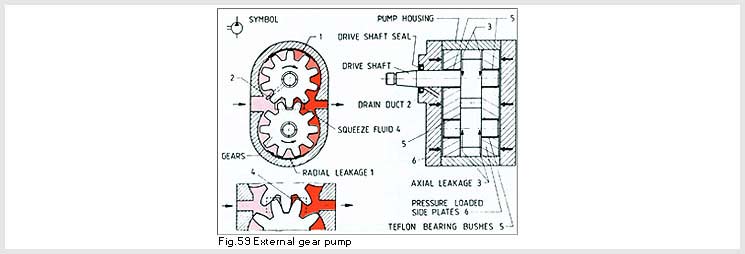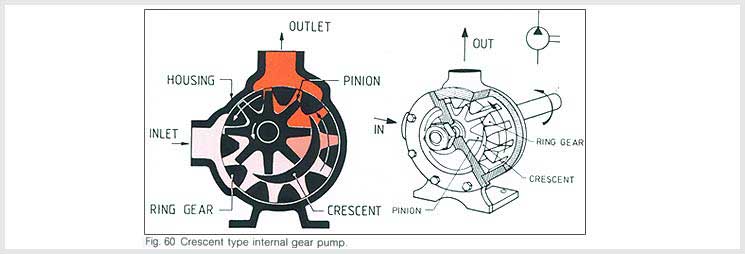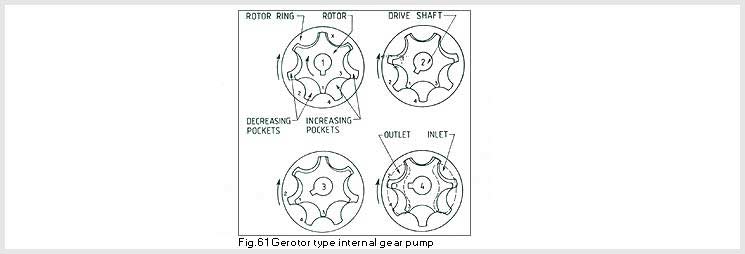|
Our Product Range
|
 |
 |
Home »
Info
Center » Classification of the Pumps
Classification of the Pumps
Industrial hydraulic pumps can be
manufactured in a variety of shapes, sizes, and pumping mechanisms, and are
almost without exception of the "positive displacement" type. This
implies that the outlet is completely sealed from the inlet. Thus,
theoretically, all the hydraulic fluid which is drawn into the pump must be
discharged through the outlet. However, some minor quantities of fluid are
lost because of clearance gaps and internal lubrication channels. Hence, a
worn pump is less efficient than a well maintained or new pump.
The pumps are basically classified according to the pumping mechanism. Some
of the common types include the following:
External Gear Pumps
A gear pump consists of a pump housing in which a pair of precisely meshing
gears run with minimal radial and axial clearance. The external gear pumps
works on the principle of using two rotating gears which disengages at the
suction side of the pump, which creates voids allowing atmospheric pressure
to force fluid into the pump. Fluid is pumped out along the outer perimeter
of the housing to the discharge side, and the gears mesh at the center to
discharge the fluid. The gears are supported by bearings on both sides,
which allows high discharge pressure capabilities.

Crescent Type Internal Gear Pump
This type pump is gaining increasing popularity as a high-pressure,
low-noise pump suitable for a variety of hydraulic fluids. It is
comparatively smaller than the external gear pump for the same flow
displacement conditions. The pump shaft drives the pinion which facilitates
the movement of internal ring gear (rotor). As with external gear pumps, the
fluid fills the cavities (voids) formed by the rotating teeth and the
stationary crescent. Both the outer gear and the pinion functions to
transport fluid through the pump.

Gerotor type internal gear pump
The gerotor pumps works in a similar manner to the crescent pump. The pump
shaft is also keyed to the inner rotor and both rotor and rotor ring rotate
in the same direction. The tooth count of the inner is one less than rotor
ring. The arrangement forms pumping cavities. Whilst the rotors turn
clockwise , pumping cavities are gradually opening up on the pump inlet side
until they reach point X and then decrease their volume gradually as they
rotate toward the outlet side. The tips of the inner rotor come in contact
with the outer rotor ring to seal the pumping pockets.

Fixed displacement vane pump (unbalanced)
In Fixed Displacement Vane Pumps, an eccentrically arranged slotted rotor
with movable vanes inserted into the slots rotates within a circular track.
These pumps are said to be “unbalanced", as all the pressure
exposed pumping cavities are situated on one side of the rotor. This
imbalance causes the drive shaft bearing to wear prematurely in specific
conditions where the pump is used above its pressure rating.
Fixed Displacement Vane Pump
(balanced)
Balanced vane pumps use an elliptical track ring instead of the circular
track housing, which permits the use of two sets of intake and outlet ports.
The diametrically opposed pump outlet openings cancel out the radial
pressure loading on the rotor shaft bearing. To improve sealing between the
vane tip and the elliptical track, pressure from the high pressure outlet is
applied to the underside of the vanes
Variable displacement Vane Pump
In these pumps, the heavy pressure control spring forces the movable
circular track ring into the extreme right hand position which is maximum
eccentric position. As the maximum "throw" position can be
adjusted, the maximum pumping capacity of this pump is also adjustable. The
spring force is opposed by the pressure arising from workload resistance.
Thus, when peak pressure has been reached, the pressure control with its
spring decreases the flow from the pump.
Piston pumps
Piston pumps are the high performance
pumps generally used in industrial and mobile hydraulics. The radial design
of the piston pumps enable it to handle a high pressures up to 65 Mpa.
Generally, piston pumps are "loafing" at such low pressures, and
with modern design, piston pumps often reach an overall efficiency of 95% or
even more.
Swash Plate Axial Piston Pump (fixed or variable displacement)
Swash plates pump have a rotating
cylinder containing pistons. A spring pushes the pistons against a
stationary swash plate, which sits at an angle to the cylinder. As the
cylinder block rotates, the piston shoes (slippers) follow the stationary
(non-rotating) swash plate, causing the pistons to reciprocate. The
retracting pistons move past the inlet port slot thus drawing fluid into the
expanding pumping chambers. As the cylinder block rotates further, the
pistons are forced back into the cylinder block and while moving past the
outlet port slot, they force the fluid into the system.
Bent axis piston pump (variable or fixed displacement)
In the bent axis piston pump, the
cylinder block rotates at an offset angle to the drive shaft. The piston
rods are attached to the drive shaft flange by means of ball joints. The
pistons draw fluid into the cylinder bores as they rotate past the inlet
port slot. Pump displacement varies with the offset angle. With the angle of
the fixed displacement pumps being set around 25° and for variable
displacement pumps, the cylinder block may be swiveled around the center
point to adjust the offset angle.
Radial piston pump with thrust ring actuation (variable displacement)
These pumps have a drum-shaped cylinder
block that rotates about a stationary central pintle or valve shaft. The
cylinder block houses the pumping pistons which reciprocate as it rotates.
As the cylinder block rotates, centrifugal force, charging pressure, or
sometimes springs, cause the pistons to follow the inner surface of the cam
ring. The cam ring (thrust ring or reaction ring) together with its support
block are eccentrically movable to adjust the piston stroke and thus the
pump flow.
Radial piston pump (fixed displacement)
These pumps are used for high pressure
application, for example up to 63 Mpa. In such cases, the pistons are
usually moved by an eccentric crankshaft, thus acting radially outwards.
Such pumps may have three or more cylinders, which can have their output
either combined or delivered separately.








